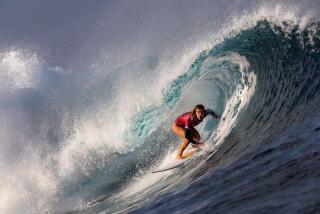Floating to the top
- Share via
Haleiwa, Hawaii — On a sunny afternoon, some of the world’s best-known surfers are practicing the sport’s most demanding move: waiting for waves.
Scrunched together on a queen-size bed, they watch a video -- a pastiche of themselves and their friends jumping off yachts near an island and charging waves. They howl with delight at each other’s on-screen quirks. “She has the funniest kickouts!” hoots one.
They have gathered in a rented house, a few steps and a quick paddle away from a reef along Oahu’s fabled string of big-wave breaks, on the day before the Roxy Pro Hawaii. Because Roxy pays all of them in some form to promote the brand, they are usually referred to -- with awe, with disdain, it depends on who’s talking -- as the Roxy girls.
They prefer the more wholesome “Roxy team riders.” A tribe of natural athletes bound by a common passion, they’re most at home with each other and the people who tend them. The older girls spent their teen years together, traveling to far-flung contests and photo shoots, their smiles captured in glistening sunlight on the posters they sign at autograph events.
“We kind of raised each other,” says Veronica Kay.
In the last few years, the number of girls who catch waves has skyrocketed. They ride almost everywhere that men do and compete on a two-tier professional circuit of about 100 surfers. Many receive free clothing or boards from corporate sponsors, but only about half snare a contract to endorse such surf wear or accessory brands as Rip Curl, Billabong or Roxy.
So what makes a Roxy girl? Not necessarily success as a pro. Only four of the 17 top-ranked surfers invited to compete in the Roxy Pro Hawaii represent the brand.
“It’s an unexplainable formula,” says Danielle Beck, a Roxy marketing manager. “It comes down to their lifestyle, their personality, their marketability. There’s a spark about them that we believe in. Seventy-five percent of it has to do with their surfing level.”
In this particular bedroom on the eve of the contest’s opening day last month are a few members of the Roxy team: Laura Enever, a promising 13-year-old Australian with platinum hair; Sofia Mulanovich and Chelsea Georgeson, close friends but fierce rivals in their early 20s; Kay, 24, a Southern California surfer whose main value to Roxy these days is as a bikini-clad action figure on posters and in promotions; and 35-year-old Lisa Andersen, a four-time world champion and still an icon of women’s surfing.
And then there’s Pauline Menczer. Dark-haired and 34, she’s not a Roxy girl. A pro for 18 years, Menczer has had one of the longest careers on the circuit, securing berths in the Roxy Pro Hawaii and the Billabong Pro Maui, but the Australian has yet to snag a yearly stipend from any surf company. Other surfers share their free clothing and rooms in their rental houses. Accustomed to tight situations with no extra bed, she totes an air mattress.
Menczer and her predicament raise an issue that dogs Roxy despite its undisputed success in raising the profile of women’s professional surfing: Does parent company Quiksilver Inc. choose surfers to promote the brand and glorify the sport based on their talent -- or their looks?
But whether they surf for Roxy or not, whether they compete in the Roxy Pro or simply support friends, they want to go to the mecca of winter surfing -- the place that every pro, male or female, well-funded or scrambling for a couch, must grapple with to earn any respect. That place is the North Shore of Oahu, and among the many lessons it teaches is this: Waves are fickle.
Seven-mile miracle
The drive from the Honolulu airport on the South Shore of Oahu -- near the glittery sprawl of Waikiki Beach -- to the North Shore starts on an urban highway with reminders for turnoffs to Pearl Harbor. It continues on Kamehameha Highway, winding through pineapple fields in central Oahu before reaching Haleiwa, the main town of the North Shore.
From Ali’i State Beach unfolds the “seven-mile miracle,” immortalized in postcards and surf movies from “Big Wednesday” to “Blue Crush.” The stretch of reef breaks includes Waimea, off the lushly green Waimea Bay Beach Park; the unforgiving Banzai Pipeline that can swell to triple overhead; Rocky Point; and Sunset Point.
North Shore locals believe in keeping “the country country.” There is just one resort hotel here and, more remarkably, one Starbucks. Roosters and chickens skitter down roads and across the muddy clearings, past sagging shops and houses, with little chance of being squished by traffic.
But in November and December, when North Pacific storms hurl giant swells, the community swells too, with surfers, their handlers, and the photographers and writers who chronicle them.
Three men’s contests -- the Van’s Triple Crown of Surfing -- roughly coincide with the Roxy Pro, and for weeks, while everyone waits for contest-caliber waves, Ke Nui Road, one lane along the beachfront, turns into a kind of fraternity and sorority row. Rental cars parked haphazardly along the road attract local thieves who prey so frequently that patrolling police officers warn visitors to leave nothing inside.
On the wooden gates outside the “Roxy House,” a thick chain threads through two slats, though it’s just for show; the padlock is unsecured. Flip-flops litter the front door stoop, a feeble attempt to keep out sand. Inside, cups and water bottles clutter the table. Beds look as if they have been hastily abandoned in the rush for the dawn waves. Surfboards line the walls, including one with a pink and magenta bikini bottom, size small, dangling from its tip.
“Oh, God, the house is a mess,” says Rachel Greff, a onetime Roxy model and now team manager in residence.
Over several weeks, the house’s population ebbs and flows: Preteens arrive for a surf camp then depart; Roxy surfers come and go, sometimes opting to stay elsewhere when the four-bedroom house gets too crowded.
Another house up the road -- the site of the 2003 WB reality surf series “Boarding House: North Shore” -- accommodates the Roxy marketing staff, who stock the surfers’ refrigerator, socialize with them, schedule their Roxy promotional events in Oahu and aggressively control their exposure to the media. The girls need their space, especially the competitors.
“Hawaii is the most intimidating place on Earth,” says Andersen, and she’s not talking about the social pressure. “These are the proving grounds of surfing.”
The waves are big and powerful and unpredictable. Drop-ins to the curl can be steep. A wipeout can mean a painful raking across coral. And everyone is watching -- other surfers, surf company reps and always photographers. “As much as people like contests,” says one Roxy team rider, “they mostly remember a great picture.”
But contests matter -- especially here. “If you win an event in Hawaii, it looks good on your resume,” says Andersen.
Rosy Hodge knows that. A late arrival to the Roxy House, the 17-year-old South African traveled at Roxy’s expense to vie for the contest’s one wild card spot. “All your heroes are there,” she says. “Lisa and Sofia Mulanovich and Chelsea Georgeson. You’ve watched them on TV and then you’re staying in a house with them.”
Hodge had a restless first night. Hot, humid winds lashed at the palm trees. The ocean offered no lullaby; thick waves smacked the shore with a heaving thud. She awakened at 3, eager to surf at dawn. When she finally hit the waves, 20 people dotted each peak. “The lineup is pretty mellow, but no one gives an inch,” Hodge says later. “No one really cares that I’ve never been to Hawaii -- ‘Oh, just give her some waves.’ It’s every man for himself.”
She fumbled around, then gave it up and told a housemate her troubles. “I feel like such a kook, I can’t turn the way I usually do,” she says to Veronica Kay.
“You’re not alone,” Kay replies.
Kay -- VK, friends call her -- first landed in the Roxy house at 15, scared and unsure of herself.
“I had to prove I was a good surfer and not just out to look good in a bikini.” Determined, she surfed up and down the North Shore, even getting a head gash when her board clobbered her. But her competitive drive waned once she joined the Roxy boat trips to places like Fiji and Indonesia, where she would surf for photographers. “I lost my desire to compete,” she says. “I had everything I wanted.”
On the second day of the Roxy Pro contest window, the swell at Ali’i State Beach in Haleiwa still underwhelms. Waiting for the right stuff is maddening: The waves are too small. Instead of an offshore wind that neatly manicures the waves, it’s blowing onshore. Or cross-shore. Or it’s raining. Or it was raining and now the sea is choppy.
To fill the time, the Roxy riders “free surf” for the photographers, play tennis, go for a run. Hodge curls up and writes in a journal that she will share with her boyfriend back home. And there is a birthday celebration at a local sushi spot, no media allowed. Roxy marketers don’t like their surfers to be seen drinking alcohol. It doesn’t fit the clean image they’re selling to their underage customers.
One afternoon, word arrives that each Roxy Pro heat will put four surfers, not the elite level’s customary two, in the water because Hawaiian officials want to move the contest along. Sitting back on a bed, Mulanovich, a 21-year-old Peruvian, listens quietly as the others talk. Wavy brown hair streaked with blond falls around her face, tight and unsmiling. In the last few years, she has charged to the top of the rankings. If she wins here, she will clinch her first world title, and she has no intention of losing. But she is annoyed. Four-person heats mean more battling for waves. “It’s supposed to be more about surfing,” she says, “and not about being hassled.”
Still waiting for contest waves a few days later, some of the surfers slip into bikinis that have been shipped to the Roxy House, and set out for the Pupukea break. They are fit and tan, stomachs as flat as the boards they ride. VK has changed into her second suit of the day, and the other surfers nod approvingly. She crosses the sand, where six photographers are lined up, shooting video and stills, salty air whipping around their tripod-mounted cameras with 600-millimeter telephotos. There are other surfers out there too.
Menczer is in the water, praying, she says later, that not every lens is trained exclusively on a Roxy surfer. A magazine image of her executing a fabulous turn could jump-start her efforts to get a contract.
“It rips my head she doesn’t have a sponsor,” says VK. Surfing contests pay, but they also cost: entrance fees, travel, rooms. A contract can make all the difference. VK’s allows her to worry about not getting enough vegetables and how to calm her lovesick fiance, who hates that she travels.
Menczer worries about where to sleep. “I’m one of the winningest surfers,” she says, dripping after surfing Rocky Point one morning. “I’ve won like 28 contests.”
She speculates on why sponsors avoid her. “You’ve got to be either young or a model, pretty much. Sometimes I really feel like the odd man out -- with the dark hair and the freckles,” she says.
Maybe it’s her look, maybe it’s her age, maybe it’s her boisterous personality. (At dinners, she’s been known to turn table decorations into a costume.) Maybe, she says plaintively, it’s that no company will touch her because no company has touched her.
“They could market me as the silly one,” she says, grinning.
More to the point, though, it’s the Anna Kournikova question, the issue that intrudes on all women’s sports. Are the young women who win the contracts and magazine coverage the best athletes or the best-looking athletes?
“Some of those girls,” Menczer says, referring to the Roxy surfers, “all they can do is stand on a board. They can’t turn.” She jumps to her feet, bends her knees gingerly, throws her arms into a surfing pose and smiles. “I really believe in surfing it’s who you know, not what you’ve done.” Ironically, Menczer seems to know everyone. She survives on the kindness of close friends like VK.
“I’m not too embarrassed to take hand-me-downs,” she say.
She also gets boards from shaper Victor Otten and has persuaded the maker of her arthritis medicine to give it to her for free.
Housing, though, is a relentless challenge. Week by week, Menczer cobbles together accommodations. Waiting for the Roxy Pro, she hopped from house to house, spending four nights in a place rented by a magazine photographer before having to move on with her air mattress.
“It’s stressful,” she admits. “Sometimes I think of the other girls styling and being taken out to dinner. I’m happy for them. I just wish I was 10 years younger.”
Try 20 years younger.
The perils of Pauline
“We love Pauline, she hangs with us,” says Randy Hild, the Quiksilver marketing exec who took the Roxy brand from zero to annual sales exceeding a quarter of a billion dollars. “Today, if there were a Pauline Menczer who was 13 or 14 years old, that would be different.”
Roxy scouts its surfers young, hoping to identify a future world champion. It signed the 12-year-old Hawaiian phenomenon Carissa Moore to a four-year Roxy contract. Still, as Hild seeks out the next generation, he worries about the current image. “We don’t want to have the reputation that we just hire and put on contract pretty girls who can’t surf.”
But Roxy is selling clothes -- overwhelmingly, it turns out, to girls who don’t surf. For those customers, Hild needs Roxy girls with a “beach look” that telegraphs they’re having fun with their friends while stashing surfboards in their cars. “They are more approachable to the girl ... who lives in the Midwest but is intrigued by the beach,” he says.
The next day the sun returns, but contest waves fail to materialize and Mulanovich paddles out to practice. When she drops in, looking astonishingly tiny and in danger of being swallowed, she fluidly rides toward shore, buttery sunlight bouncing off her neon rash guard. For a moment, she looks like a circus rider on a galloping horse, poised between animal and air. She bounds out of the water, nods to admirers gathered on the sand and heads for the house.
By the end of the week, the contest is finally on.
Hodge does not get her wild card spot, and Mulanovich finishes second -- high enough point-wise to claim the world title. She wasn’t sure of that until she glided into shore to the sound of people chanting “Sophia.”
She was draped in leis and paraded around the sand. After a party that night, she headed off to Maui for the next contest.
So did Menczer. She had had a line on a place to stay. A Roxy surfer invited her to share a hotel room. “She said she’d pay,” Menczer says.
All she would need was her air mattress.







